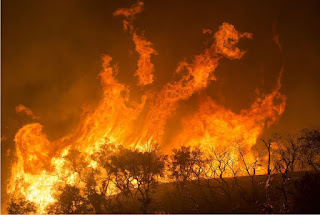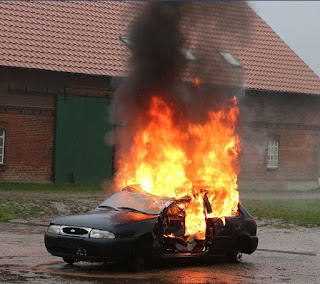Does Auto Insurance Cover Wildfire Damage?
By Diane Tait
 |
| Image courtesy pixabay |
For the past few weeks, nearly everyone has been completely
absorbed in the Coronavirus pandemic.But I for one remember a time 22-years ago when another disaster reared
its ugly head in Florida. June, July and
August of 1998 produced wildfires of epic proportion in the Sunshine
State. The reason I remember it so
clearly is because that's when I moved back to Jacksonville only to see
white flakes rain down on my backyard one morning.
“Wait a minute, it doesn’t snow in Florida,” I said to
myself only to realize a split second later that it wasn’t snow that was
falling but ash. I can still remember the
clouds of smoke wafting slowly down my street looking like fog and smelling like
a preview of hell. I also recall I-95 and I-4 being closed down
by wildfires that burned right up to the edge of the interstate. I don’t recall if any fatalities were
produced by the firestorm that raged for several months before finally being
brought under control. But I do know
that entire neighborhoods were burnt to the ground in several parts of the
state. So too were vehicles that were
either charbroiled where they stood in front of homes or were blackened as
their occupants abandoned them to run for their lives.
The reason I’m recounting this blast from the past is that
the past year has seen wildfires burning in California and Australia that
destroyed property and cost lives. While
most of the world is focused on a killer pathogen, I just wanted to remind my
readers that wildfires can and do happen with increasing regularity. While your homeowner’s policy can help you
repair or replace homes that are damaged or destroyed by wildfire, should your
vehicle be burnt to a crisp, it would be nice to know if your auto insurance
policy is going to help you get back on the road.
 |
| Image courtesy pxfuel |
What kind of coverage do you have? – If you only carry liability
insurance, this won’t help you repair or replace a vehicle that is fire
damaged. You need comprehensive coverage
that includes wildfire damage as a covered peril. While most auto policies include this
coverage, it would behoove you to read your policy to make sure it is
included. If not and your car is damaged
or destroyed by a wildfire, the policy won’t be worth the paper it’s printed
on. More importantly, if your claim is
denied, not only will you be out a car, truck, SUV or van, but you will still
be responsible for paying off remaining car loan. If your policy doesn’t include wildfire coverage,
I urge you to have it added before fire season sets in, since no insurer will
sell you the coverage once fires start to burn.
What does comprehensive coverage cover? As opposed to collision coverage that comes into
effect when your vehicle is damaged in an accident, comprehensive coverage pays
for damage caused by non-collision perils such as theft, vandalism, hail, lightning
or other acts of God. If your windshield is cracked by a flying rock,
comprehensive coverage kicks in to replace the windscreen. If you accidentally hit a deer with your car,
comprehensive pays to remove the carcass and repair the damage done. If your car sinks like a submarine in rising
floodwaters or the engine catches fire, comprehensive is there to repair the
damage. If a windstorm topples a big oak
tree that squashes your car flat, comprehensive will repair or replace your vehicle.
While many drivers hesitate at filing an insurance claim for fear that
their rates will rise, when you file a comprehensive claim, many insurance
carriers won’t issue a surcharge unless you file three or more such claims in a
3-year period. (You should verify this
fact with your insurance agent.) Most
insurers won’t charge you for filing a claim for a cracked windshield. However, if you hit three deer in swift succession,
don’t be surprised if your rates rise.
Unless you select a policy that includes a zero deductible for comprehensive
claims, you’ll be required to pay the deductible you selected when you bought
your auto insurance coverage regardless of whether the damage was caused by an
act of God or not.
 |
| Image courtesy flickr |
When smoke gets in your eyes. While I’ve never personally experienced a car
fire, I’ve seen cars on fire several times.
Most of the time they are a result of mechanical problems or fuel leaks
under the hood that cause the vehicle to burst into flames. When this happens, not only is it extremely
scary to the driver and any passengers in the vehicle, but it’s also extremely
deadly since not only can noxious fumes quickly incapacitate the occupants, but
the driver also has to contend with safely guiding the stricken vehicle out of
the flow of traffic before the entire vehicle is involved.
If you ever detect smoke wafting out from under the hood of your vehicle,
don’t try to make it to the next exit.
Your best bet is to pull onto the shoulder of the road as quickly as
possible and turn off the ignition before running away from the vehicle. Many people make the mistake of popping the
hood only to have fire roar out of the engine compartment. Since fire requires oxygen, popping the hood
is just what a smoldering fire needs to turn into a raging inferno. Even if you have a fire extinguisher in hand,
it’s better to wait for the fire department to arrive than to try to extinguish
an engine fire on your own.
The same thing is true if you should ever encounter a wildfire. While staying in the vehicle is a good idea
provided traffic is moving, if traffic should gridlock and you see smoke and
flames heading your way, the only time you should jump out is if you see a
fire-resistant shelter nearby. Realize that
jumping out at the last minute could be deadly since wildfires can move much
faster than you can run. If you wind up driving
through an area that is on fire, keep going since turning around on a narrow road
could wind up getting you trapped. Should
you become trapped in your vehicle as a firestorm approaches, leave the engine
running and duck down below the level of the windows to avoid the radiant heat
produced by the flames. Turn the AC onto
recirculate and cover any exposed skin with a dry cloth, jacket or towel. Don’t wet the fabric since this will only
flash to steam which could burn you as badly as the fire. Try not to panic and stay inside your vehicle
until the wall of flames passes. Unlike
the movies, your car won’t instantly explode into a ball of flame.
While fire is a frightening prospect to encounter on the road, the most
important thing to remember is when things get hot you have much better odds of
surviving if you don’t lose your cool.
Diane Tait owns and operates A&B Insurance. To find
out more about how you can save money on insurance, go to her site or fill out the form at right.


Having been a volunteer firefighter in my youth, I can tell you that the last thing you want to mess with is a fuel fire. Better to lose a car than your life. Let the professionals deal with a car fire.
ReplyDelete